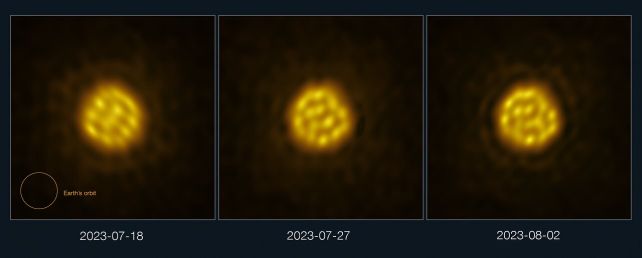On a star 180 light-years away, astronomers have simply imaged the floor modifications that happen as a result of fixed biking of warmth inside.
The three ensuing snapshots signify a fortnight of shifting patterns on the star R Doradus, a pink large star almost 350 occasions wider than the Solar, roiling and boiling with convection because it undergoes the final phases of its lifespan.
The brand new research marks the primary time humanity has been capable of picture this course of in a star aside from the one on the heart of our personal Photo voltaic System. The modifications astronomers mapped on the floor of R Doradus signify huge bubbles of heated fuel, 75 occasions the dimensions of our personal Solar, rising to the floor and subsiding once more, on timescales a lot shorter than astronomers had anticipated.
“That is the primary time the effervescent floor of an actual star could be proven in such a method,” says astronomer Wouter Vlemmings of Chalmers College of Expertise in Sweden. “We had by no means anticipated the info to be of such top quality that we might see so many particulars of the convection on the stellar floor.”
R Doradus is the proper object to review if we wish to perceive floor stage modifications on stars aside from the Solar. It’s extremely massive, which implies there’s extra floor space. The star’s exercise is larger, too. To see a major stage of element at even this comparatively quick interstellar distance, a bigger measurement with greater actions goes to be simpler to picture.
We all know stars have convection processes as warmth generated within the core bubbles outwards in direction of the floor. On the Solar, we see this in convection granules that are typically round 1,000 kilometers (620 miles) throughout, a bit bit smaller than the state of Texas. They boil up from the middle, and fall away across the edges, persisting for round 20 minutes earlier than dissipating.
Deeper down, granulation happens on bigger scales. Mesogranules are granules which are between round 5,000 and 10,000 kilometers throughout, with a lifespan of about three hours. And supergranules measure round 32,000 kilometers throughout, and grasp round for round 20 hours.
Utilizing the highly effective Atacama Giant Millimeter/submillimeter Array telescope in Chile, Vlemmings and his colleagues hoped to discern particulars of this course of in one other star, removed from the Photo voltaic System. And their outcomes had been astonishing.

“Convection creates the gorgeous granular construction seen on the floor of our Solar, however it’s laborious to see on different stars,” says astronomer Theo Khouri of Chalmers College of Expertise.
“With ALMA, we’ve got now been capable of not solely immediately see convective granules – with a measurement 75 occasions the dimensions of our Solar! – but additionally measure how briskly they transfer for the primary time.”
The convection granules are big, and the researchers weren’t completely positive why. The granules on R Doradus may very well be the pink large equal to mesogranules or supergranules, or a special sort of granulation particular to pink large stars. They is also completely different sorts of granule superimposed to ship a pronounced impact.
What we will not do, at this level, is immediately correspond the granules on R Doradus to any identified habits of the Solar. We all know they contain convection, however what makes the granules so huge is unknown right now.
frameborder=”0″ enable=”accelerometer; autoplay; clipboard-write; encrypted-media; gyroscope; picture-in-picture; web-share” referrerpolicy=”strict-origin-when-cross-origin” allowfullscreen>
As well as, the granules seen on R Doradus appear to have a cycle of round a month, which was so much sooner than anticipated, given what we’ve got noticed on the Solar.
However pink large stars are very completely different from the Solar, which is comfortably in the course of its lifespan. Purple large stars are those who have run out of hydrogen of their heart and are powered by shell burning, which is the fusion of hydrogen in a shell across the core. This course of is what puffs the star as much as many occasions its authentic measurement. Astronomers predict that the Solar’s pink large section will see it presumably broaden out to the orbit of Mars.
As a result of there are limitations on what we will observe from such big distances, there’s so much we do not find out about pink giants. The very quick lifespan of the convection granules in comparison with photo voltaic granules could also be simply enterprise as normal at this late stage of a star’s life.
“We do not but know what’s the motive for the distinction. Plainly convection modifications as a star will get older in ways in which we do not but perceive,” Vlemmings says.
The pictures of R Doradus signify a primary, essential step in direction of understanding these peculiar modifications.
The analysis has been printed in Nature.





